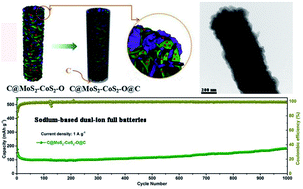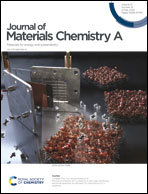Cobalt and oxygen double doping induced C@MoS2–CoS2–O@C nanocomposites with an improved electronic structure and increased active sites as a high-performance anode for sodium-based dual-ion batteries†
Abstract
A cobalt-doping induced heterogeneous structure of MoS2–CoS2 grown on one-dimensional tubular carbon (ODTC) has been synthesized. The CoS2 nanoparticles can inhibit the free growth of MoS2 nanosheets and obtain a MoS2–CoS2 heterostructure with an ultra-small size, which improves the electronic conductivity of the electrode material affected by the internal electric field. Furthermore, oxygen-incorporated C@MoS2–CoS2 accompanied by a double carbon coating process can add active sites, provide a buffer layer and further improve the electronic conductivity of the electrode material, which overcomes the shortcomings of intrinsic low electronic conductivity and structural instability of MoS2. Serving as an anode material for sodium ion batteries, the C@MoS2–CoS2–O@C nanocomposites show superior sodium storage performance with high capacity (466.1 mA h g−1 at 1 A g−1 after 200 cycles) and excellent rate capability. And the sodium dual-ion full batteries deliver a reversible discharge capacity of 182.2 mA h g−1 at 1 A g−1 over the voltage range of 1.0–4.4 V after 1000 cycles.



 Please wait while we load your content...
Please wait while we load your content...